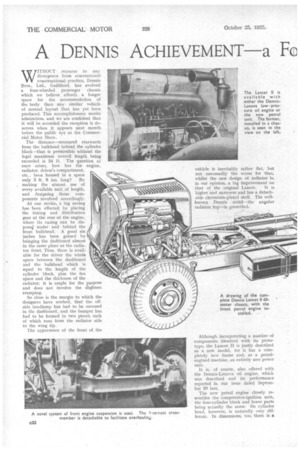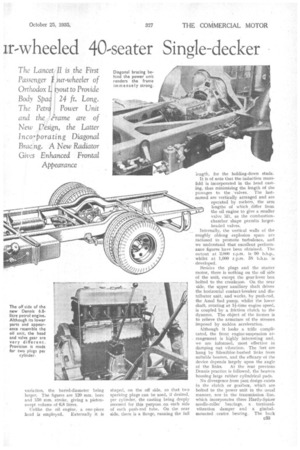A DENNIS ACHIEVEMENT -a Fc
Page 74

Page 75

Page 76

If you've noticed an error in this article please click here to report it so we can fix it.
ir-wheeled 40-seater Single-decker
The Lancet II is the First Passenger I lur-wheeler of Orthodox L yout to Provide Body Spac 24 ft. Long. The Petro Power Unit and the irame are of New Pesign, the Latter Incorporating Diagonal Bracmg. A New Radiator GiVi.!S Enhanced Frontal
Appearance
WITHOUT• recourse to any divergence from conventional constructional practice, Dennis Bros., Ltd., Guildford, has evolved a four-wheeled passenger chassis which we believe affords a longer space for the accommodation of the body than any similar vehicle of normal layout that has yet been produced. This accomplishment merits admiration, and we are confident that it will be accorded the reception it deserves when it appears next month before the public eye at the Commercial Motor Show.
The distance—measured rearwards from the bulkhead behind the cylinder block—that is permissible without the legal maximum overall length being exceeded is 24 ft. The question at once arises, how has the engine, radiator, driver's compartment, etc.. been housed in a space only 3 ft. 6 ins. long? By making the utmost use of every available unit of length, and designing those components involved accordingly.
At one stroke, a big saving has been effected by placing the timing and distribution gear at the rear of the engine, where its casing can be dispose ‘l under and behind the front bulkhead. A good six inches has been gained by bringing the dashboard almost in the same plane as the radiator front. Thus, there is available for the driver the whole space between the dashboard and the bulkhead which is equal to the length of the cylinder block, plus the fan space and the thickness of the radiator; it is ample for the purpose and does not involve the slightest cramping.
So close is the margin to which the designers have worked, that the offside headlamp has had to be recessed in the dashboard, and the bumper has had to be, formed in two pieceg, each of which runs from the radiator side to the wing tip.
The appearance of the front of, the
Although incorporating a number of components identical with its prototype, the Lancet II is justly described as a new model, for it has a completely new frame and, as a petrolengined machine, an entirely new power unit.
It is, of course, also offered with the Dennis-Lanova oil engine, which was described and its performance reported in our issue dated September 20 last.
The new petrol engine closely resembles the compression-ignition unit, the four-cylinder block and lower parts being actually the same. Its cylinder head, however, is naturally very different. In dimensions; too, there is a variation, the barrel-diameter being larger. The figures are 120 mm. bore and 150 mm. stroke, giving a pistonswept volume of 6.8 litres.
Unlike the oil engine, a one-piece head is employed. Externally it is shaped, on the off side, so that two sparking plugs can be used, if desired, per cylinder, the casting 'being deeply recessed for this purpose each side of each push-rod tube. On the near side, there is a flange, running the full length, for the holding-down studs:
It is of note that the induction manifold is incorporated in the head casting, thus minimizing the length of the passages to the "valves. The last;named arevertically arranged and are operated by rockers, the arm lengths of which_ differ froth the oil engine to give a smaller valve lift, as the combustionchamber shape permits larger-.
headed valves.
Internally, the vertical walls of the roughly oblong explosion space are radiused to promote turbulence, and we understand that excellent performance figures have been obtained. The output at 2,000 r.p.m. is 90 b.h.p., whilst at 1,000 r.p.m. 58 b.h.p. is developed.
Besides the plugs and the starter motor, there is nothing on the off side of the unit, except the gear-lever box bolted to the crankcase. On the near side, the upper auxiliary shaft drives the horizontal contact-breaker and distributor unit, and works, by push-rod, the Amal fuel pump, whilst the lower shaft, rotating at 1k-time engine speed, is coupled by a friction 'clutch to the dynamo. The object of the former is to relieve the armature of the stresses imposed by sudden acceleration.
Although it looks a trifle complicated, the front engine-suspension arrangement is highly interesting and, we are informed, most effective its damping out vibration. The feet are hung by Silentbloc-hushed links from suitable bearers, and the efficacy of the device depends IargOy upon the angle of the links. At the rear previous Dennis practice is followed, the bearers housing large rubber cylindrical pads.
No divergence from past design exists in the clutch or gearbox, which are bolted to the power unit in the .usual manner, nor in the transmission line, which incorporates three Hardy-Spicer needle-roller bearings, a. torsionalvibration damper and a gimbalmounted .centre bearing. The back axle, of the underslung-worm type, is also as on former Lancets.
The foot-brake system incorporates a • Dewandre-Lockheed vacuum-servo motor with hydraulic connections to external cylinders on all wheels, the rear pairs of shoes being also operable by the hand lever, through the now well-known Dennis system of doubleended lever, lost-motion device and accessible setscrew adjustment.
A splendid example of rigid lightL weight construction, the frame incorporates diagonal bracing, and the influence of the design of the smaller models in the Dennis range is apparent here.
Kicked up slightly over the front axle and more so over the rear, the tapering channel longitudinals are 81 ins. deep, 34 ins, wide, and approximately in. thick at their largest section, At the extreme front, a forged girder crossmember carries the radiator and power unit. Its ends are bolted to vertical faces on the dumbiron-lug sides, and it is noteworthy that . the radiator, cross-member, engine and gearbox can be withdrawn forwards as a complete -assembly.
From just behind. the rear bearers two diagonal 'box-members run rearwards, meeting at the centre of the second cross bracing, about 4 ft. farther back. The front ends of these run some distance within the side members, to the flanges of which they are riveted. For similar, attachment. at the point of the A formed by the
diagonals, the second cross-member has wide flanges cut away between the junctions with the frame and the diagonals. All the channel-bracing members are well " skeletoned" for lightness, and their• wide ends avoid concentration of stressing.
Not only does this structure enable the frame to resist " lozenging," but also it prevents deflection of the side
members that might be caused by the absence of a. rigid rear engine mounting, and removes the need for a sturdy superstructure bridging the frame behind the engine.
There are three more cross-members of similar type, shaped according to requirements, and diminishing in depth with the longitudiaals, whilst at the extreme rear, a tubular member with flanged ends is bolted to the sidemember webs.
All roadsprings are mounted directly under the main-frame members. Those at the rear are underslung semielliptics, and those at the front are of the reverse-camber type and are attached above the axle.
There arc many detail refinements on this interesting chassis, particularly
in the make-up of its power unit. Space prohibits their enumeration here, but a close inspection of the machine will be Well rewarded. In this respect, because of its good appearance, and for the important matter of its frame length, the new Dennis Lancet II has a big claim to be:considered the "last word" in passenger-vehicle development along orthodox lines.
















































































































































